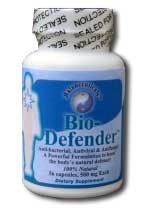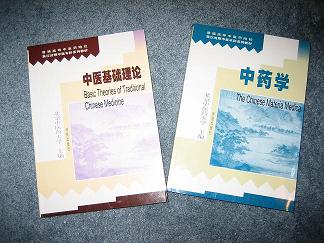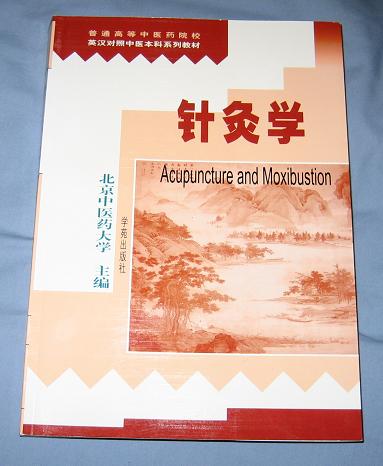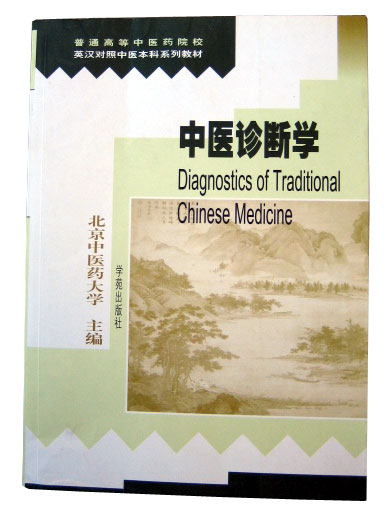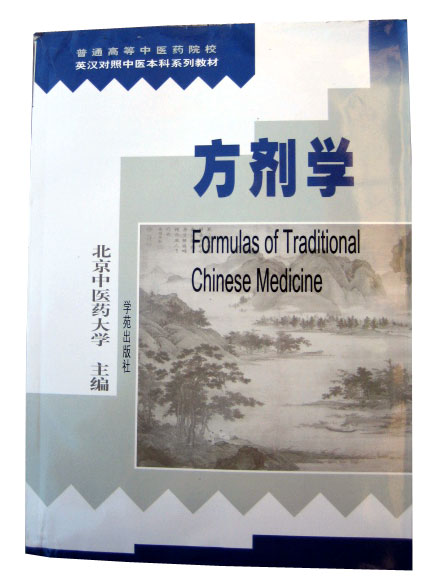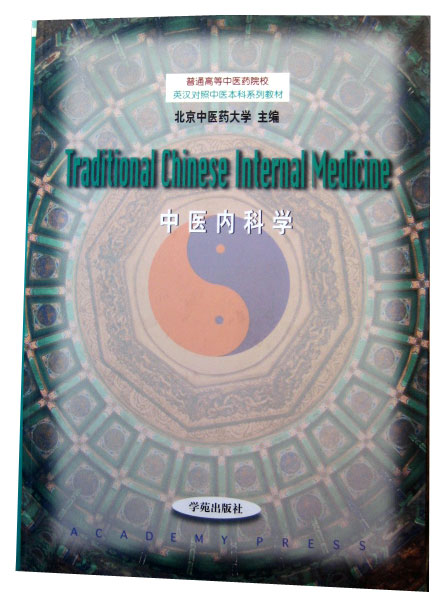| Home | About Us | Herbal Tea Series | Balanceutical Formulas | TCM Textbooks | Others Products | Services | Herb Info |
 |
 |
|
|
A Key to Understanding Traditional Chinese Medicine ----Introducing Two Resource Books Whether you are a herbalist or a health food store owner, or a health practitioner who wants to help your customer understand the increasingly popular traditional Chinese medicine (TCM) formulas, or you are just one of those health conscious people who want to take your health care into your own hands, and make sensible choices and taking advantage of the reliable and time honored TCM products Chinese have used for centuries for good health, you do not want to miss this opportunity to learn the basics of TCM including the seemingly mystic medical theories and the outwardly exotic material medica. Basic Theories of Traditional Chinese Medicine and The Chinese Materia Medica, are two of a set of seven that are published by China Academy Press as English-Chinese Colleagiate Textbooks in traditional Chinese medicine for institutions of TCM of higher Learning edited by Beijing University of Traditional Chinese Medicine. These books may help you do all the above and much, much more. Ever since their publication in 1998 these two books have become a much sought after bible in traditional Chinese medicine for those non Chinese readers who are not familiar with Chinese concept of the universe, the human body, health, disease, prevention and treatment. Do not be daunted by the fact that this set of books is designed for college use. You do not need college levels of training in physics, chemistry, math, calculus, etc which are the prerequisite courses to take before a college degree to medicine (conventional medicine, that is.) to understand. You do not have to learn Chinese language to read them because they are in both languages. If you want to learn Chinese, it is a perfect tool for you. Is the language “Chinglish” (meaning hard coined English few can understand)? Largely, “No!” No, because a few English speakers are among the few editors whose painstaking work with their excellent knowledge of both Chinese language and Chinese culture made the books highly readable and understandable. The implied “yes” to the answer, lies in the fact that on the one hand, the two textbooks are written and edited by well-versed Chinese TCM experts including well known doctors, researchers, professors from research and teaching institutions in China, and as authentic writing for teaching, they have to be very faithful to the basic TCM tenets, including the Chinese culture-bound concepts and logics, and on the other hand, they need to be understood by English speaking readers who may not be familiar with Chinese culture. It is always a formidable task to build a flexible and no nonsense bridge between the East and the West outlooks and concepts, theories and logics. This gigantic and overwhelming mission, improved by the English editors made the set enormously interesting and fantastically rewarding for the readers. Here are the Tables of Content for the two volumes: Basic Theories of Traditional Chinese MedicineIntroduction
Chapter One Yin-Yang and the Five Elements Section 1. The Theory of Yin-Yang Section 2. The Theory of Five Elements Chapter Two Visceral Manifestation Section 1. Introduction Section 2. Five Zang-Viscera Section 3. The Six Fu-Viscera Section 4. Extraordinary Organs Section 5. the Relationships between the Zang-Viscera and Fu Viscera Chapter three Qi, Blood, Body Fluid and Vitality Section 1. Qi Section 2. Blood Section 3. body Fluid Section 4. Relationship among Qi, Blood and Body Fluid Section 5. Vitality Chapter Four Meridians Section 1. The Concept and Composition of the Meridians Section 2. Regular Meridians Section 3. The Eight Extra Meridians Section 4. Divergent meridians, Collaterals, Meridian Tendon and Skin areas Section 5. The Physiology of Meridians and Application of Meridian Theory Chapter Five Etiology and Pathogenesis Section 1. Etiology Section 2. pathogenesis Chapter Six Pathological Mechanism Section 1. Basic pathological Mechanism Section 2. The Pathological Mechanism of Exogenous Febrile Diseases Section 3. The Pathological Mechanism of the Five Endogenous Evils Section 4. pathological Mechanisms of the Zang-Viscera and Fu-Viscera Chapter Seven Principles of Treatment and Prevention Section 1. Prevention Section 2. Principles of Treatment Retail Price: 38.00 USD The Chinese Materia MedicaGeneration Discussion Chapter 1. Producing Areas, collection and Prevention Chapter 2. Theory on Drug Properties Chapter 3. Applications of Chinese Drugs Systematic Considerations Chapter 1. Drugs of Relieving Exterior Syndromes Chapter 2. Heat-Clearing Drugs Chapter 3. Purgative Drugs Chapter 4. Anti-Rheumatics Chapter 5. Aromatic Drugs for Resolving Dampness Chapter 6. Drugs for Inducing Diuresis and Excreting Dampness Chapter 7. Drugs for Warming the Interior Chapter 8. Drugs for regulating Qi Chapter 9. Drugs for Removing Food Stagnation Chapter 10. Anthelmintics Chapter 11. Hemostatics Chapter 12. Drugs for promoting Blood Circulation and Relieving Blood Stasis Chapter 13. Drugs resolving Phlegm and Relieving Cough and Asthma Chapter 14. Tranquilizers Chapter 15. Drugs for Calming the Liver and Checking Wind Chapter 16. Drugs for Resuscitation Chapter 17. Tonics for Deficiency Syndromes Chapter 18. Astringents Chapter 19. Drugs for External Use and Others Appendix Retail Price: 48.00USD A Key to Understanding Acupuncture and Moxibustion-----Introducing Acupuncture and Moxibustion If you want to learn acupuncture and moxibustion, the ancient arts of Chinese healing here is the best resource for you. Acupuncture and Moxibustion is one of a set of seven that are published by China Academy Press as English-Chinese Colleagiate Textbooks in traditional Chinese medicine for institutions of TCM of higher Learning edited by Beijing University of Traditional Chinese Medicine. Ever since its publication in 1999, it is a favorite reading material for non Chinese readers who are not familiar with Chinese concept of the universe, the human body, health, disease, prevention and treatment. Do not be daunted by the fact that this set of books is designed for college use. You do not need college levels of training in physics, chemistry, math, calculus, etc which are the prerequisite courses to take before a college degree to medicine (conventional medicine, that is.) to understand. You do not have to learn Chinese language to read them because they are in both languages. If you want to learn Chinese, it is a perfect tool for you too. Is the language “Chinglish” (meaning hard coined English few can understand)? Largely, “No!” No, because a few English speakers are among the few editors whose painstaking work with their excellent knowledge of both Chinese language and Chinese culture made the books highly readable and understandable. The implied “yes” to the answer, lies in the fact that on the one hand, the two textbooks are written and edited by well-versed Chinese TCM experts including well known doctors, researchers, professors from research and teaching institutions in China, and as authentic writing for teaching, they have to be very faithful to the basic TCM tenets, including the Chinese culture-bound concepts and logics, and on the other hand, they need to be understood by English speaking readers who may not be familiar with Chinese culture. It is always a formidable task to build a flexible and no nonsense bridge between the East and the West outlooks and concepts, theories and logics. This gigantic and overwhelming mission, improved by the English editors made the book enormously interesting and fantastically rewarding for the readers. Here is the Table of Content for the volume: IntroductionPart I: Meridians and PointsChapter 1 A General Introduction to the Meridians
Chapter 2 An Introduction to Acupoints
Chapter 3 The fourteen Meridians’ Acupuncture Points and the Extraordinary points
Chapter4ExraordinaryPoints
Part II Acupuncture and Moxibustion TechniquesChapter 1 Filiform Needle
Chapter 2 moxibustion
Chapter 3 Other Acupuncture Therapies
Chapter 4 Nine Needles in the Ancient Times and the Methods Listed in Internal Classic Chapter 5 Scalp AcupunctureChapter 6 Ear AcupuncturePart III Acupuncture and Moxibustion TreatmentChapter 1 introductionChapter 2 Acupuncture Therapy
Retail price: 45.00USD Diagnostics of Traditional Chinese Medicine
This is one of the English-Chinese Colleagiate Textbooks in Traditional Chinese Medicine for Institutions of Traditional Chinese Medicine of Higher Learning edited by Beijing University of Traditional Chinese Medicine. Diagnostics of TCM is a study concerning the examination of body, diagnosis f diseases and differentiation of syndromes under the guidance of the basic theories of TCM. TCM diagnostics include examining patient, collecting data relating to health, sorting out, analyzing, synthesizing and reasoning the data on the basis of basic theories of TCM, and finally determining the characteristics of clinical manifestations and the way of health change when diseases occur. So correct diagnosis is the prerequisite for effective treatment and prevention. During the long period of medical practice, doctors of TCM have accumulated very rich experience in diagnosis making TCM diagnosis a unique and comprehensive diagnostic system. Table of Contents Chapter 1 Introduction Section 1 the Main Contents of Diagnostics of TCM Section 2 The Principles of Diagnosis in TCM Section 3 Brief History of TCM Diagnostics Chapter 2 Observation Section 1 Observing Vitality, Color, Figure and Posture Section 2 Local Observation Section 3 Observation of Excreta Section 4 Tongue Observation Section 5 Modern Research on Observation Chapter 3 Auscultation and Olfaction Section 1 Auscultation Section 2 Olfaction Chapter 4 Interrogation Section 1 The Purpose and Method of Interrogation Section 2 Contents of Interrogation Chapter 5 Palpation Section 1 Pulse Examination Section 2 Body Palpation Section 3 Modern Research on Pulse Reading Chapter 6 The Eight Principles of Syndrome Differentiation Section 1 Syndrome Differentiation on the Yin and Yang Section 2 Syndrome Differentiation on Exterior and Interior Section 3 Syndrome Differentiation on Cold and Heat Section 4 Syndrome Differentiation on Deficiency and Excess Section 5 Modern Research on the Eight principles of Syndrome Differentiation Chapter 7 Etiological Syndrome Differentiation Section 1 Six Evils Section 2 pestilential Evils Section 3 seven Emotions Section 4 Improper Diet and Overwork Section 5 parasites and Surgical Trauma Chapter 8 Qi, Blood and Body-Fluid Syndrome Differentiation Section 1 Qi Syndrome Differentiation Section 2 Blood Syndrome Differentiation Section 3 Syndrome Differentiation of Both Qi and Blood Section 5 Syndrome Differentiation of Body Fluid Section 6 Modern Research on Qi, Blood and Body-Fluid Syndrome Differentiation Chapter 9 Visceral Syndrome Differentiation Section 1 Syndrome Differentiation on Liver and Gallbladder Section 2 Syndrome Differentiation on Heart and Small Intestine Section 3 Syndrome Differentiation on Spleen and Stomach Section 4 Syndrome Differentiation on Lung and Large Intestine Section 5 Syndrome Differentiation on Kidney and Urinary Bladder Section 6 Syndrome Differentiation on Compound Visceral Syndromes Section 7 Modern Research on Visceral Syndrome Differentiation Chapter 10 Meridian Syndrome Differentiation Section 1 Syndromes of the Twelve Regular Meridians Section 2 Syndromes of the Eight Extra meridians Chapter 11 Syndrome Differentiation of Exogenous Diseases Section 1 The Six Meridian Syndrome Differentiation Section 2 Wei-Qi-Ying-Xue ( Defense-Qi-Nutrient-Blood) Syndrome Differentiation Section 3 triple-Jiao Syndrome Differentiation Chapter 12 Medical Record Section 1 The Attentive Items for Writing Medical Record Section 2 The Content of Medical Record Retail Price: 39.00USD Formulas of Traditional Chinese Medicine
This is one of the English-Chinese Colleagiate Textbooks in Traditional Chinese Medicine for Institutions of Traditional Chinese Medicine of Higher Learning edited by Beijing University of Traditional Chinese Medicine. A formula is a combination of herbs targeted to certain diagnosed disease used upon properties of the herbs used and the need of the problem. One of the advantages of using a compound formula over a single herb, is that herbs are used not only to achieve desired synergetic effects but also to counterbalance toxins and side effects of other herbs. According to statistics there are more than a million formulas available for practitioners, and practitioners may adapt the formula to the aimed disease by making certain changes. Formulas in this book is the major ones used for a long time. They are classified into different categories for practical treatment or prevention of certain diseases. CONTENTSIntroduction Part One Chapter One The Relationship of Formulae to Syndrome Differentiation and the Establishment of Therapies Section 1 The Relationship of Formula to the Syndrome Differentiation Section 2 The Relationship of Formula to Establishment of Therapy Section 3 Common Regulations for Designing Formula Chapter Two Design of Formula Section 1 Structure of Forming a Formula Section 2 Modification of a formula Chapter Three Classification of Formulae Chapter Four Preparations of Formulas Chapter Five administration of Formulae Section 1 The Method of Decocting Herbs Section 2 Methods of Oral Administration Section 3 Methods of External Application Part Two Elaboration Chapter One Exterior- relieving Formulae Section 1 Formulae for Relieving the Exterior with Pungent-Warming Herbs Section 2 Formulae for relieving the Exterior with Pungent-Cool Herbs Section 3 Formulae for Relieving the Exterior by Strengthening the Genuine Chapter Two Purgative formulae Section 1 Cold Purgative Formulae Section 2 Warm Purgative Formulae Section 3 Moistening Purgative Formulae Chapter Three Digestive Formulae Chapter Four Mediative Formulae Section 1 Formulae for Mediating Shaoyang Section 2 Formulae for Harmonizing the Liver and Spleen Section 3 Formulae for Regulating Gastrointestinal Tract Chapter Five Heat-Clearing Formulae Section 1 Formulae for clearing Heat from the Qi Stage Section 2 Formulae for Clearing the Nutrient Stage and Cooling Blood Section 3 Formulae for Clearing Heat and Poison Section 4 Formulae for Clearing Visceral Heat Section 5 Formulae for Clearing Summer-heat Section 6 Formulae for Clearing Away the Deficient Heat Chapter Six Interior Warming Formulae Section 1 Formulae for Warming the Middle to Dispel Cold Section 2 Formulae for Restoring Yang to rescue Collapse Section 3 Formulae for Warming Meridians to Expel Cold Chapter Seven Tonic Formulae Section 1 Formulae for Tonifying Qi Section 2 Formulae for Tonifying Blood Section 3 Formulae for Tonifying Both Qi and Blood Section 4 Formulae for Tonifying Yin Section 5 Formulae for Tonifying Yang Chapter Eight Stringent Formulae Section 1 Formulae for Consolidating the Exterior to Stop Sweating Section 2 Formulae for Astringing the Lung to Alleviate Cough Section 3 Formulae for Consolidating the Intestine to Cease Diarrhea Section 4 Formulae for Consolidating the Essence to Control Emission and Enuresis Section 5 Formulae for Uterine Bleeding ad Vaginal Discharge Chapter Nine Sedative Formulae Section 1 Sedative Formulae with Heavy Herbs Section 2 Sedative Formulae with Tonic Herbs Chapter Ten Formulae for Resuscitation Section 1 Cold- Natured Formulae for resuscitation Section 2 Warm-Natured Formulae for Opening Orifices Chapter Eleven Formulae for Regulating Qi Section 1 Formulae for Activating Qi Section 2 Formulae for Lowering the Adverse Flow of Qi Chapter Twelve Formulae for Regulating Blood Section 1 Formulae for Promoting Blood Circulation to Remove Stasis Section 2 Formulae for Arresting Bleeding Chapter Thirteen Formulae of Eliminating Dampness and Diuretic Section 1 Formulae for Drying Dampness and resolving the Turbidity Section 2 Formulae for Clearing Away Heat and Excreting Dampness Section 3 Formulae for Inducing Diuresis to Remove Dampness Section 4 Formulae for Warming and Resolving Water-Dampness Section 5 Formulae for Diuresis by Purgation Section 6 formulae for Expelling Wind and Dampness Chapter Fourteen Formulae for Eliminating Phlegm Section 1 Formulae for Drying Dampness and Resolving Phlegm Section 2 Formulae for Clearing Away Heat and Resolving Phlegm Section 3 Formulae for Moistening Dryness and Resolving Phlegm Section 4 Formulae for Warming and Resolving Cold-Phlegm Section 5 Formulae for Dispelling Wind and Resolving Phlegm Chapter Fifteen Formulae for Wind Section 1 Formulae for Dispelling Exogenous Wind Section 2 Formulae for Stopping Endogenous Wind Chapter Sixteen Formulae for Dryness Section 1 Formulae for Dispersing Exogenous Dryness Section 2 Formulae for Nourishing Yin to Moisten Dryness Chapter Seventeen Parasite-Expelling Formulae Chapter Eighteen Emetic Formulae Appendix One Index of Formula Names Appendix Two Pinyin-English Cross Reference of Formula Names Retail Price: 45.00USD Traditional Chinese Internal Medicine
This is one of the English-Chinese Colleagiate Textbooks in Traditional Chinese Medicine for Institutions of Traditional Chinese Medicine of Higher Learning edited by Beijing University of raditional Chinese Medicine. It is a bridge course between basic theories and clinic practice. In its long history of development TCM accumulated a very large body of knowledge on internal medicine including etiology, pathology, taxonomy and therapeutic methods. Internal medicine is a discipline to systematically deal with internal diseases by using principle of diagnosis and treatment based on an overall analysis of the illness and the patient’s condition under the guidance of TCM theory. Its extensive contents mainly consist of two major types of diseases, seasonal diseases caused by exogenous factors and miscellaneous diseases due to internal disorders. ContentsGeneral Discussion Chapter 1 The Development of Traditional Chinese Internal Medicine Chapter 2 The Basis of Traditional Chinese Internal Medicine Section 1. Etiology Section 2 Pathology Section 3 Taxonomy Section 4 Therapeutics Chapter 3 Methods of Clinical Practice and Writing of Medical Record in Traditional Chinese Internal Medicine Section 1 Method of Clinical Practice in Traditional Chinese Internal Medicine Section 2 General requirements for Traditional Chinese Internal Medicine Record Section 3 Written Form and Contents of In-patient Internal Medicine record Section 4 Written Forms and Contents for the First Medical record of Internal Outpatient Systematic Considerations Common Cold Cough Bronchial Wheezing Syndrome Panting Syndrome Lung Distension Sputum Retention Spontaneous Perspiration and Night Sweat Blood Syndrome Palpitation Pectoral Pain and Stuffiness Insomnia Melancholia Manic and Depressive Psychosis Epilepsy Stomachache Vomiting Diarrhea Dysentery Constipation Hypochondriac Pain Jaundice Accumulation and Aggregation Tympanites Headache Dizziness Apoplexy Edema Stranguria Retention of Urine Diabetes (Xiao Ke) Arthralgia Wei (Atrophy) Syndrome Fever Due to Internal Disorders Prescriptions (Index) in the Book Retail Price: 75.00USD
|

